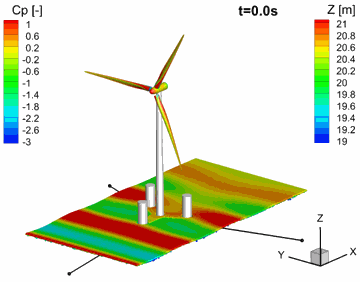Off-shore Wind Turbines
| Wind energy is one of the most substantial renewable energy resource. Historical trends suggest development of on-shore wind turbine size and power capacity over last three decades. However, many high potential sites on land are already taken and others are hard to utilise e.g. difficult access, high altitude. Therefore, recent trend is to exploit off-shore wind potential and take advantage of the available space and steady wind. Shallow water regions suitable for constructing bottom-fixed off-shore wind turbines are limited and for sea depths exceeding 30-60 m, floating structures are economically more feasible. Hence, emphasis is placed on the development of floating off-shore wind turbines (FOWTs). |
|
Objectives
The main objective of the project is to develop a coupled model of floating off-shore wind turbines. The aerodynamic loads on the rotor are computed using the Helicopter Multi-Block (HMB) flow solver. The hydrodynamic loads on the support platform are computed using the Smoothed Particle Hydrodynamics (SPH) method, which is mesh-free and represents the water and floating structures by a set of discrete elements, referred to as particles. The motion of the floating offshore wind turbine is computed using a Multi-Body Dynamic Model (MBDM) of rigid bodies and frictionless joints. Mooring cables are modelled as a set of springs and dampers.
Coupled model
All solvers were validated separately before coupling. The HMB solver was validated against experimental data of MEXICO project and NREL Phase VI experiments. The SPH solver was validated against measured data for half-buoyant cylinder entry into calm water. The multi-body solver was validated for simple mechanism of known solution e.g. slider crank in 2D and 3D, quick return mechanism and gyroscopic wheels. The communication between the solvers was established through the Message Passing Interface (MPI), where the MBDM is executed as a single process and is dedicated to start SPH and HMB parallel solvers. Coupling was achieved by employing a weakly coupled approach, namely the parallel, conventional, staggered method. Current results using a machine of 10-MW rated power, show that the developed method is reliable and accurate (Leble and Barakos 2016).

This work is funded by Marie Sklodowska-Curie Host Fellowships Program: FP7-PEOPLE-2012-ITN-309395 – new Materials And Reliability In Offshore Wind Turbines Technology “MARE-WINT”.
Contacts
George Barakos George.Barakos@Glasgow.ac.uk
Vladimir Leble v.leble.1@research.gla.ac.uk
Publications
- Leble, V., and Barakos, G. (2016) Demonstration of a coupled floating offshore wind turbine analysis with high-fidelity methods. Journal of Fluids and Structures, 62, pp. 272-293. (doi:10.1016/j.jfluidstructs.2016.02.001)
- Leble, V., and Barakos, G. (2016) Forced pitch motion of wind turbines. Journal of Physics: Conference Series, 753, 022042. (doi:10.1088/1742-6596/753/2/022042)
- Leble, V., and Barakos, G. N. (2016) Trailing and leading edge flaps for load alleviation and structure control. In: Ostachowicz, W., McGugan, M., Schröder-Hinrichs, J.-U. and Luczak, M. (eds.) MARE-WINT: New Materials and Reliability in Offshore Wind Turbine Technology. Springer International Publishing, pp. 103-114. ISBN 9783319390949 (doi:10.1007/978-3-319-39095-6_7)



